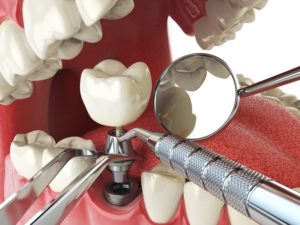Patients can find long-lasting and highly effective tooth replacements with dental implants. But what are the components that make up this restorative dental appliance?
An abutment connects the dental prosthetic above the gumline and the supporting anchor in the jaw. Read on to find Dr. Goldberg’s recently published article regarding the abutment portion of a dental implant fixture.

What Is a Dental Implant Abutment?
Dental implant abutments can be a confusing topic. Let’s talk about a single implant, which would replace a single tooth. There are 3 components: the implant or fixture, the crown or cap, and an “invisible” connector called an abutment.
The “implant” or “fixture” is the actual titanium cylinder that is placed into the jawbone. Using a crude term, this is the “screw.” The “crown” or “cap” is the tooth that you see when you smile in the mirror: it’s your replacement tooth. However, to connect these two parts, you need the third component: this is the abutment. You can view a diagram of these three parts on my website: go to “For Patients,” then “Patient Education,” and look for the Information Sheet, “General Info Regarding Dental Implants.”
There are two basic types of abutments: stock and custom. A stock abutment is pre-manufactured by implant companies, and it is taken off of a shelf to be used. A custom abutment is fully customized by the dental laboratories. Materials can also vary. The most common is titanium, but gold and zirconia are other options. The manufacturing process is also another variable: some are milled from a block of material, some are cast from wax patterns.
Types of Implant Abutments
Now that you are familiar with the type, the category, and the materials, how does your dentist select which is appropriate for you? There are a lot of variables, but the biggest ones are location in the mouth, amount of available bone, and type of gum tissue.
An implant in the top front of the mouth oftentimes requires a custom abutment. The bone in this region is angled, and esthetics are critical. There is minimal room for error, and the “emergence profile,” meaning how the tooth exits from the gum, is important. In the back of the mouth, you can get away with a lot more. Although the emergence profile isn’t as important from an esthetic standpoint, it can be important from a functional standpoint so that you don’t trap lots of food and have irritated gums.
So what is the cost of an abutment? It varies greatly. A fair range to put into an article such as this would be $500 to $1,000. Keep this in mind when you are getting quotes from your dentist or if you are interviewing multiple offices! You may not be comparing apples to apples.
The information above covers abutments for single implants. There are other situations calling for dental implant abutments, too. You may have a bridge, a denture, or an All-On-Four type of appliance. These all use various types of abutments.
In summary, although an abutment is a component you’ll never see, they are important. Your dentist needs to choose the type of abutment that’s going to get the job done properly for you to help provide proper esthetics and function.
Implant Dentistry Experts in Succasunna, NJ
Dr. Goldberg has been performing implant procedures for 27 years. He is a Diplomate of the American Board of Oral Implantology / Implant Dentistry, a Diplomate of the International Congress of Oral Implantologists, and a Fellow of the American Academy of Implant Dentistry. He also lectures to dentists in the field of implantology. For a free consultation, including a free 3-D scan (if necessary), please call his office at 973.298.5893.
